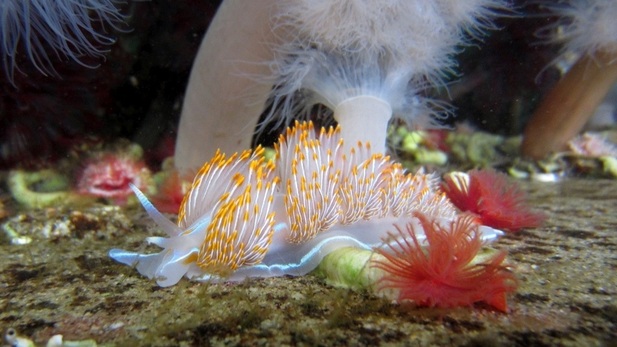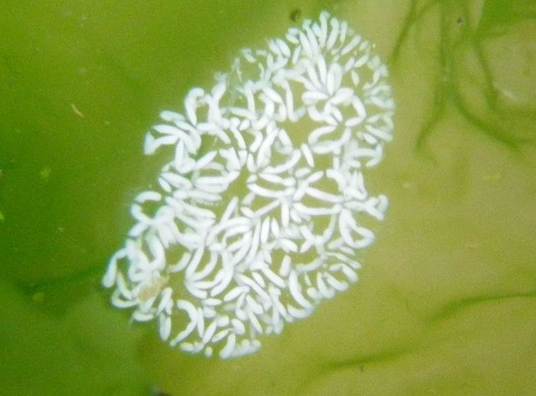Opalescent nudibranch, thick-horned nudibranch* • Hermissenda crassicornis
Opalescent nudibranchs and a ribbon of eggs found on the Hakai Institute dock. Photos by Kate Adams (top), Christian Kelly (bottom left), and Julie Mundy (bottom right).
Identification
This colourful nudibranch's furry appearance is due to the many long, thin cerata (fingerlike respiratory projections) that project from its back translucent whitish back (dorsum) behind its horn-like rhinophores. These cerata are white and orange — the amount of each colour varies from just a little orange at the tip, to nearly entirely orange — with a bright white stripe running the length of each ceras*. There is usually a central orange line running along the centre of the back and bordered by two bright blueish-white lines, though colours may vary and the orange line may be absent. Bright blueish-white lines also run along the oral tentacles and along the sides of the foot. In some lights the colours of this nudibranch seem to glow. This distinctive nudibranch grows to 8 cm long.
This colourful nudibranch's furry appearance is due to the many long, thin cerata (fingerlike respiratory projections) that project from its back translucent whitish back (dorsum) behind its horn-like rhinophores. These cerata are white and orange — the amount of each colour varies from just a little orange at the tip, to nearly entirely orange — with a bright white stripe running the length of each ceras*. There is usually a central orange line running along the centre of the back and bordered by two bright blueish-white lines, though colours may vary and the orange line may be absent. Bright blueish-white lines also run along the oral tentacles and along the sides of the foot. In some lights the colours of this nudibranch seem to glow. This distinctive nudibranch grows to 8 cm long.
|
Habitat & Range
This nudibranch can be found in a variety of different habitats, including soft mud flats, rocky areas, and eelgrass beds, as well as man-made structures such as docks and floats. It inhabits the lower intertidal and subtidal to depths of 35 m. Its known range extends from Alaska south to Northern California*. Similar Species Other nudibranchs found on the Central Coast have similarly "furry" appearances and colouring, such as the white-and-orange-tipped nudibranch (Janolus fuscus) and the BC aeolid (Catriona columbiana). The former has cerata in front of its rhinophores as well as behind, and the latter has orange on its rhinophores and oral tentacles. |
* Fun fact! A 2016 study found that what was previously called H. crassicornis along both sides of the Pacific Ocean (Alaska to Baja California in the northeast, and Russia and Japan in the northwest) is actually a species complex, with one species in the northwest and two in the northeast, overlapping in Northern California. These two species can be distinguished by their cerata: the more northern H. crassicornis has a white stripe in each ceras, whereas the more southern H. opalescens doesn't. See this blog post by The Marine Detective for more details and a link to the study.
|
Intriguing Info
The life of an opalescent nudibranch can be violent. Individuals who run into each other will fight, especially if the run-in included head-on contact. Generally, the nudibranch that was closer when the fight broke out will get the first bite and, consequently, win the fight. The winner tends to eat the loser. Another nudibranch species, Phidiana hiltoni, may also attack opalescents.
Opalescent nudibranch eggs look like long strings of link sausages, which they leave attached to algae or eelgrass. Each egg casing houses 1-4 eggs.
iNaturalist
https://www.inaturalist.org/taxa/495552-Hermissenda-crassicornis
The life of an opalescent nudibranch can be violent. Individuals who run into each other will fight, especially if the run-in included head-on contact. Generally, the nudibranch that was closer when the fight broke out will get the first bite and, consequently, win the fight. The winner tends to eat the loser. Another nudibranch species, Phidiana hiltoni, may also attack opalescents.
Opalescent nudibranch eggs look like long strings of link sausages, which they leave attached to algae or eelgrass. Each egg casing houses 1-4 eggs.
iNaturalist
https://www.inaturalist.org/taxa/495552-Hermissenda-crassicornis
References
Harbo, R. M. (1999). Whelks to whales: Coastal marine life of the Pacific Northweest. Madeira Park, BC: Harbour Publishing. P. 121.
McDonald, G. Hermissenda crassicornis (Eschscholtz, 1831). Intertidal Invertebrates of the Monterey Bay Area, California. Long Marine Laboratory, University of California Santa Cruz. Santa Cruz, CA. Accessed 08/01/2016.
Wheeling, R., Helmstetler, H., and Cowles, D. (2006). Hermissenda crassicornis (Eschscholtz, 1831) Invertebrates of the Salish Sea. Rosario Beach Marine Laboratory. Accessed 14/04/2013.
Authors and editors of page
Chanda Brietzke, Kelly Fretwell, and Brian Starzomski (2016).
Harbo, R. M. (1999). Whelks to whales: Coastal marine life of the Pacific Northweest. Madeira Park, BC: Harbour Publishing. P. 121.
McDonald, G. Hermissenda crassicornis (Eschscholtz, 1831). Intertidal Invertebrates of the Monterey Bay Area, California. Long Marine Laboratory, University of California Santa Cruz. Santa Cruz, CA. Accessed 08/01/2016.
Wheeling, R., Helmstetler, H., and Cowles, D. (2006). Hermissenda crassicornis (Eschscholtz, 1831) Invertebrates of the Salish Sea. Rosario Beach Marine Laboratory. Accessed 14/04/2013.
Authors and editors of page
Chanda Brietzke, Kelly Fretwell, and Brian Starzomski (2016).







